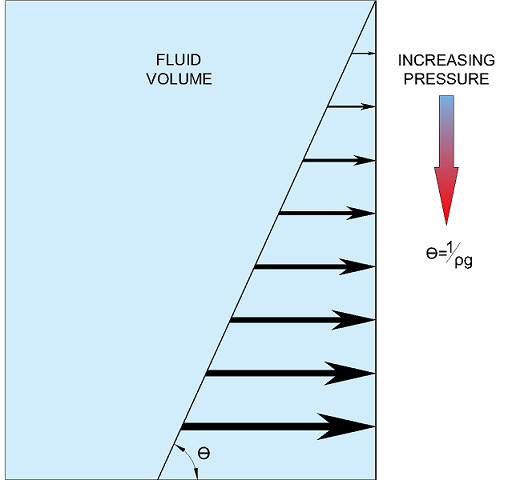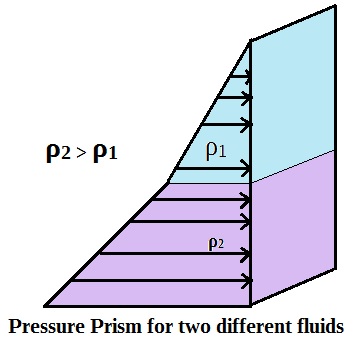pressure prism on:
[Wikipedia]
[Google]
[Amazon]
A pressure prism is a way of visually describing the variation of
 Hydrostatic pressure is the pressure exerted by a fluid at rest – for example, on the sides of a swimming pool, a glass of water or the bottom of the ocean. Its value at any given location within the fluid is the product of the fluid density (''ρ''), the depth (''d''), and the forces applied by gravity (''g'') plus any background pressures, such as atmospheric pressure.
Hydrostatic pressure on surfaces surrounding (or within) fluid volumes can be represented by the ''pressure prism'', a useful visualization technique.
Hydrostatic pressure (''P'') increases linearly with depth. Generally it can be expressed by the relationship below, where the pressure at the top is zero and at the bottom is ''ρgH'', ''H'' being the total depth of the fluid volume.
''P'' = ''ρgd'', where ''P'' is the gauge pressure above atmospheric pressure
''ρ'' is the density of the fluid
''g'' is gravitational acceleration
''d'' is the target depth of the fluid
Variation of pressure with depth is shown in the first Figure above.
Further, the centre of pressure (''COP'') on the surrounding wall can be calculated by the following formula:
''HCOP'' = ''∫px'' x ''dx'' / ''∫px'' ''dx'', where ''px'' is the pressure at ''x'' distance from the bottom
With this formula we see the height of the ''COP'' for a plane surface is ''H/3'' from the bottom, as shown in Figure 2 (left).
With two fluids of differing density in a volume, the slope of the pressure prism will not be constant over the depth. See Figure 3 (right).
The pressure prisms shown as examples pertain to situations where the surrounding surfaces are flat. Pressure prisms for fluid volumes with curved surfaces are more complex.
Hydrostatic pressure is the pressure exerted by a fluid at rest – for example, on the sides of a swimming pool, a glass of water or the bottom of the ocean. Its value at any given location within the fluid is the product of the fluid density (''ρ''), the depth (''d''), and the forces applied by gravity (''g'') plus any background pressures, such as atmospheric pressure.
Hydrostatic pressure on surfaces surrounding (or within) fluid volumes can be represented by the ''pressure prism'', a useful visualization technique.
Hydrostatic pressure (''P'') increases linearly with depth. Generally it can be expressed by the relationship below, where the pressure at the top is zero and at the bottom is ''ρgH'', ''H'' being the total depth of the fluid volume.
''P'' = ''ρgd'', where ''P'' is the gauge pressure above atmospheric pressure
''ρ'' is the density of the fluid
''g'' is gravitational acceleration
''d'' is the target depth of the fluid
Variation of pressure with depth is shown in the first Figure above.
Further, the centre of pressure (''COP'') on the surrounding wall can be calculated by the following formula:
''HCOP'' = ''∫px'' x ''dx'' / ''∫px'' ''dx'', where ''px'' is the pressure at ''x'' distance from the bottom
With this formula we see the height of the ''COP'' for a plane surface is ''H/3'' from the bottom, as shown in Figure 2 (left).
With two fluids of differing density in a volume, the slope of the pressure prism will not be constant over the depth. See Figure 3 (right).
The pressure prisms shown as examples pertain to situations where the surrounding surfaces are flat. Pressure prisms for fluid volumes with curved surfaces are more complex.


hydrostatic pressure
Fluid statics or hydrostatics is the branch of fluid mechanics that studies the condition of the equilibrium of a floating body and submerged body "fluids at hydrostatic equilibrium and the pressure in a fluid, or exerted by a fluid, on an imme ...
within a volume of fluid. When variables of fluid density, depth, gravity
In physics, gravity () is a fundamental interaction which causes mutual attraction between all things with mass or energy. Gravity is, by far, the weakest of the four fundamental interactions, approximately 1038 times weaker than the stro ...
, and other forces such as atmospheric pressure
Atmospheric pressure, also known as barometric pressure (after the barometer), is the pressure within the atmosphere of Earth. The standard atmosphere (symbol: atm) is a unit of pressure defined as , which is equivalent to 1013.25 millibars, 7 ...
are charted, the resulting figure somewhat resembles a prism
Prism usually refers to:
* Prism (optics), a transparent optical component with flat surfaces that refract light
* Prism (geometry), a kind of polyhedron
Prism may also refer to:
Science and mathematics
* Prism (geology), a type of sedimentary ...
.
Description
 Hydrostatic pressure is the pressure exerted by a fluid at rest – for example, on the sides of a swimming pool, a glass of water or the bottom of the ocean. Its value at any given location within the fluid is the product of the fluid density (''ρ''), the depth (''d''), and the forces applied by gravity (''g'') plus any background pressures, such as atmospheric pressure.
Hydrostatic pressure on surfaces surrounding (or within) fluid volumes can be represented by the ''pressure prism'', a useful visualization technique.
Hydrostatic pressure (''P'') increases linearly with depth. Generally it can be expressed by the relationship below, where the pressure at the top is zero and at the bottom is ''ρgH'', ''H'' being the total depth of the fluid volume.
''P'' = ''ρgd'', where ''P'' is the gauge pressure above atmospheric pressure
''ρ'' is the density of the fluid
''g'' is gravitational acceleration
''d'' is the target depth of the fluid
Variation of pressure with depth is shown in the first Figure above.
Further, the centre of pressure (''COP'') on the surrounding wall can be calculated by the following formula:
''HCOP'' = ''∫px'' x ''dx'' / ''∫px'' ''dx'', where ''px'' is the pressure at ''x'' distance from the bottom
With this formula we see the height of the ''COP'' for a plane surface is ''H/3'' from the bottom, as shown in Figure 2 (left).
With two fluids of differing density in a volume, the slope of the pressure prism will not be constant over the depth. See Figure 3 (right).
The pressure prisms shown as examples pertain to situations where the surrounding surfaces are flat. Pressure prisms for fluid volumes with curved surfaces are more complex.
Hydrostatic pressure is the pressure exerted by a fluid at rest – for example, on the sides of a swimming pool, a glass of water or the bottom of the ocean. Its value at any given location within the fluid is the product of the fluid density (''ρ''), the depth (''d''), and the forces applied by gravity (''g'') plus any background pressures, such as atmospheric pressure.
Hydrostatic pressure on surfaces surrounding (or within) fluid volumes can be represented by the ''pressure prism'', a useful visualization technique.
Hydrostatic pressure (''P'') increases linearly with depth. Generally it can be expressed by the relationship below, where the pressure at the top is zero and at the bottom is ''ρgH'', ''H'' being the total depth of the fluid volume.
''P'' = ''ρgd'', where ''P'' is the gauge pressure above atmospheric pressure
''ρ'' is the density of the fluid
''g'' is gravitational acceleration
''d'' is the target depth of the fluid
Variation of pressure with depth is shown in the first Figure above.
Further, the centre of pressure (''COP'') on the surrounding wall can be calculated by the following formula:
''HCOP'' = ''∫px'' x ''dx'' / ''∫px'' ''dx'', where ''px'' is the pressure at ''x'' distance from the bottom
With this formula we see the height of the ''COP'' for a plane surface is ''H/3'' from the bottom, as shown in Figure 2 (left).
With two fluids of differing density in a volume, the slope of the pressure prism will not be constant over the depth. See Figure 3 (right).
The pressure prisms shown as examples pertain to situations where the surrounding surfaces are flat. Pressure prisms for fluid volumes with curved surfaces are more complex.


References
A Brief Introduction To Fluid Mechanics aperbackby Donald F. Young, Bruce R. Munson, Theodore H. Okiishi, Wade W. Huebsch {{Reflist Fluid statics